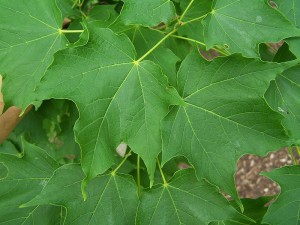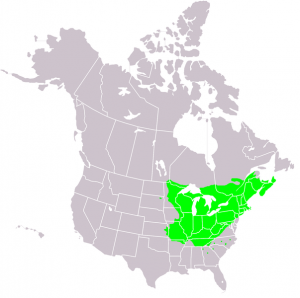This post is part of a recurring segment here on Science Decoded where I blog for the first graders at Lincoln-Hubbard Elementary School about the various units in their science program.
***
I hear you are studying trees in your science class, and I wanted to share with you some of the special aspects of a certain type of tree: The Sugar Maple.
The Sugar Maple (scientific name: Acer saccharum) is a deciduous tree. Deciduous means that its leaves change color and fall off during the Fall. A Sugar Maple tree can grow as tall as 82-115 feet, but it takes a long time to get that big. After ten years (thats older than all of you!) a Sugar Maple tree will usually only be about 16 feet tall. The leaves on a Sugar Maple tree are usually around 7-8 inches long, and have five lobes. Take a look at the picture of the leaves, do they look familiar? Do any of you have Sugar Maple trees in your backyard? What about at the school?
The Sugar Maple is a tree that can be found in hardwood forests throughout northeastern North America, which includes Canada and the United States. Take a look at this map, the green part is where Sugar Maple trees grow. Do you see New Jersey? How about Wisconsin? Sugar Maple trees grow in New Jersey where you are, and Wisconsin where I am.
Sugar Maples are very important because they are able to grow really well in shady areas and also provide habitat (places to live) for animals in the forest. This species of tree isn’t rare or endangered, but it is a special part of these forest ecosystems. An ecosystem is a biological (natural) area made of all the living and non-living parts of the environment, this means all the plants (like Sugar Maples!) animals, water, sunlight, and even soil. All of these things need to be healthy to make the environment strong. In addition to being important for the forest ecosystem, Sugar Maples also have a special ability. These trees can also be useful for people to make products like Maple Syrup.
Sugar Maple trees have a sugary sap inside them that people can harvest in the Spring by making a hole in the trunk and collecting the sap that runs out. When the sap is heated, some of the water evaporates, leaving behind syrup. Here is an example of what collecting the sap looks like, it is being drained into those buckets attached to the trees
Now I have a surprise for you! We have a special Farmer’s Market here in Wisconsin, that is one of the biggest Farmer’s Markets in the country. Have any of you ever gone to the Farmer’s Market where you live? It is a place where local farmer’s bring their fruits, vegetables, and other products to sell. Here in Wisconsin you can buy some of the products people make from Sugar Maple trees at the Farmer’s Market.
I filled up a little package for you with information about the Wisconsin Farmer’s Market, some Sugar Maple products, and even a little surprise from the University of Wisconsin’s mascot Bucky Badger. I hope you like it! Let me know if you have any questions about Sugar Maple trees!

